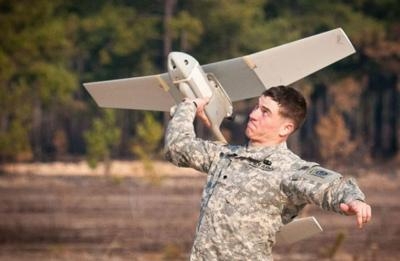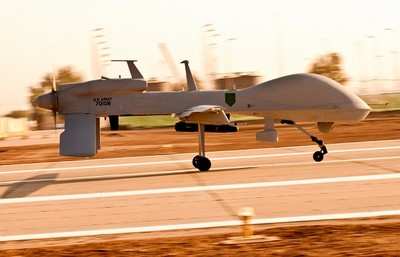Systems Increasingly Seen As Mature By Ground Troops
At a media roundtable held at Redstone Arsenal, AL Tuesday, a U.S. Army official said "we're on the tipping point of unmanned aerial systems' ability to deliver capability to the Soldier."

The official was said Col. Thomas von Eschenbach, who said that the UAS is no longer seen by Soldiers as a new system and as the months and years pass, it will "not just be used by a few, but will become integral to the Army fabric and how it fights and is used and understood," said Eschenbach, who is the UAS capability manager for Army Training and Doctrine Command.
Eschenbach and others spoke March 18 at a media roundtable at Redstone Arsenal, AL., where a celebration was held marking the Army's milestone of 2 million UAS flight hours.
Col. Timothy Baxter, project manager, UAS, noted that it took 20 years for Army unmanned aerial systems to reach 1 million flight hours. That milestone came in 2010. With increased use of those systems, it took just a few more years to reach the 2 million flight-hours milestone. He said what is most impressive is that 90 percent of total UAS flight hours were logged in direct support of combat operations. "Every one of those hours has meant something to a commander on the ground overseas engaged in combat," Baxter said.
Baxter noted that of the total 2 million flight hours, Shadow UAS logged 900,000 of those. However, as more Gray Eagles are fielded, he said he expects it to be the system with the most impressive mileage.
Rich Kretzschmar, deputy project manager, UAS, said that reaching 3 million flight hours may take longer than it did to get from 1 to 2 million because the operations tempo in theater has now leveled off.
And, as more UAS systems return to the U.S. from overseas, there could be fewer opportunities to fly them because of restricted airspace flight rules, Baxter added.
But, the UAS will play a crucial part of the Army's aviation restructure initiative, Eschenbach said.
As brigade combat teams shrink from four to three per division and as maneuver battalions are reinvested back into other BCTs, three Shadow UAS platoons will be put inside of each attack reconnaissance squadron, he said. That would add a total of 30 platoons of Shadows into the combat aviation brigade structure. Those squadrons will also contain AH-64E Apache helicopters.
However, don't expect to see a lot of new UAS models, Baxter cautioned. "Our platforms are the platforms we're going to have for the foreseeable future in the Army." Instead, he said future efforts will be in the area of new technologies for advanced payloads and improvements in man-to-unmanned teaming.

As to unmanned vs manned, Kretzschmar pointed out that UASs are not replacing pilots. Rather, he said, they are the "extension of the commander's ability to do things, extend reach, reduce risk and get better situational awareness on the battlefield."
Also in the cards for UAS is something not too sexy, but important nonetheless to a budget-challenged Army: sustainment costs.
Baxter said the UAS community has moved away from contractor logistics support to "green-suiter" maintainers, as Soldiers get their own military occupational specialty and become more proficient. In the next war, the Army may not have the luxury of setting up forward operating bases teeming with contract support. Another cost savings, he pointed out, is through applying "performance-based logistics" to contracts, so as to "incorporate better buying power."
Since Eschenbach is with TRADOC it's not surprising he sees doctrine as well as the operational environment dictating the vision of where UASs are headed. Eschenbach thinks UASs have capabilities that go far beyond the current state of reconnaissance, surveillance, security and precision strikes. His team of planners is already looking at UAS employment in "Force 2025," where UAS will vastly extend the network, meaning the reach that commanders have on the ground. As this takes place over the coming years, he said Army leaders will need to better understand the capabilities of UASs and what they can do for them. "We're asking warfighters in a smaller, leaner Army to be more expeditionary, lethal and survivable, focused on the next thing our nation asks us to do," Eschenbach concluded. In that environment, there's "plenty of future for UAS."
(Images provided by the U.S. Army)
 ANN's Daily Aero-Term (04.28.24): Airport Marking Aids
ANN's Daily Aero-Term (04.28.24): Airport Marking Aids Aero-News: Quote of the Day (04.28.24)
Aero-News: Quote of the Day (04.28.24) ANN's Daily Aero-Linx (04.28.24)
ANN's Daily Aero-Linx (04.28.24) Aero-News: Quote of the Day (04.29.24)
Aero-News: Quote of the Day (04.29.24) ANN's Daily Aero-Linx (04.29.24)
ANN's Daily Aero-Linx (04.29.24)




